Sometimes it’s the little details that are of interest, but easily passed over during renovations. Here’s an account of one day’s finds.
Tickets please
While repairing a floor in the house after some central heating work, I found a fragment of card in amongst the rubble between the joists. It was an old train ticket, from Maxwell Park to Glasgow Central. Issued by the British Railways Board, it looked ancient, but only carried the date of 8 November, and no year.
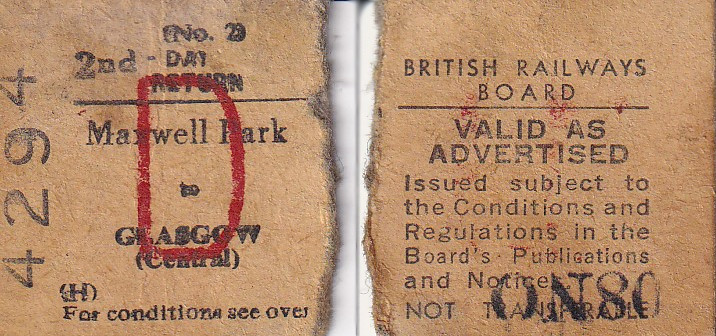
This was an Edmondson train ticket . It was invented by the station master at Brampton on the Newcastle to Carlisle line, and widely introduced in 1842, replacing hand written tickets. It came to be adopted all over the world, but to my surprise was only withdrawn in the late 1980s, when it was replaced by the modern orange and cream credit card sized ticket. I also found a 1979 copy of the Evening Times stuffed into a gap in the wall, so maybe the ticket wasn’t quite so ancient after all.
Time, please
However the same day a neighbour told me of a find amongst the joists in his attic. It was a Strathbungo beer bottle.
A bottle of Bass Pale Ale, it was marked “Bottled by Robert Adam, 6 & 7 Titwood Place, Strathbungo.”
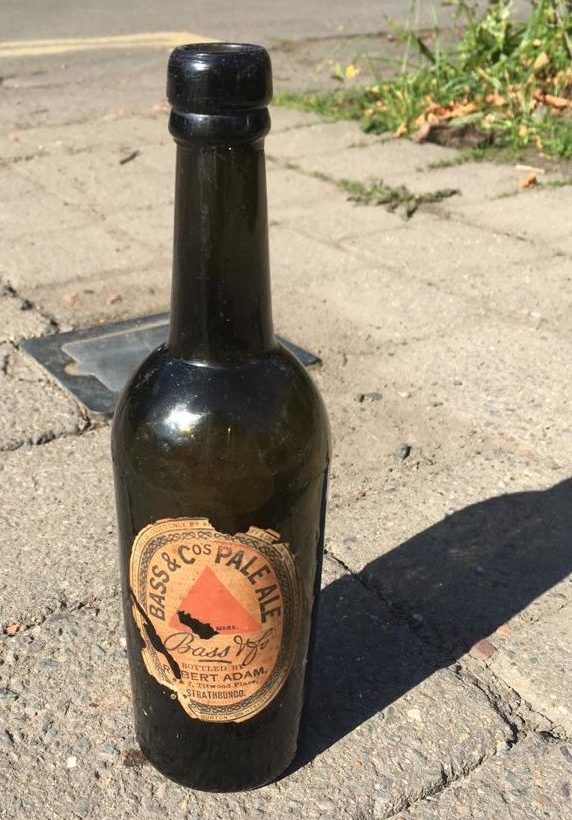
Up until the 1850s you took your own bottle to a shop to get it refilled. Brewers in Burton upon Trent, including Bass, had started to brew a lighter, more hoppy beer, which could better survive the trip to India on board a ship, particularly if bottled. This became known as India Pale Ale (IPA). By the 1880s Bass was the world’s largest brewer, and claimed you could buy its beer in every country in the world . You can see it for sale in Édouard Manet’s famous 1882 Parisian painting Un bar aux Folies-Bergère.
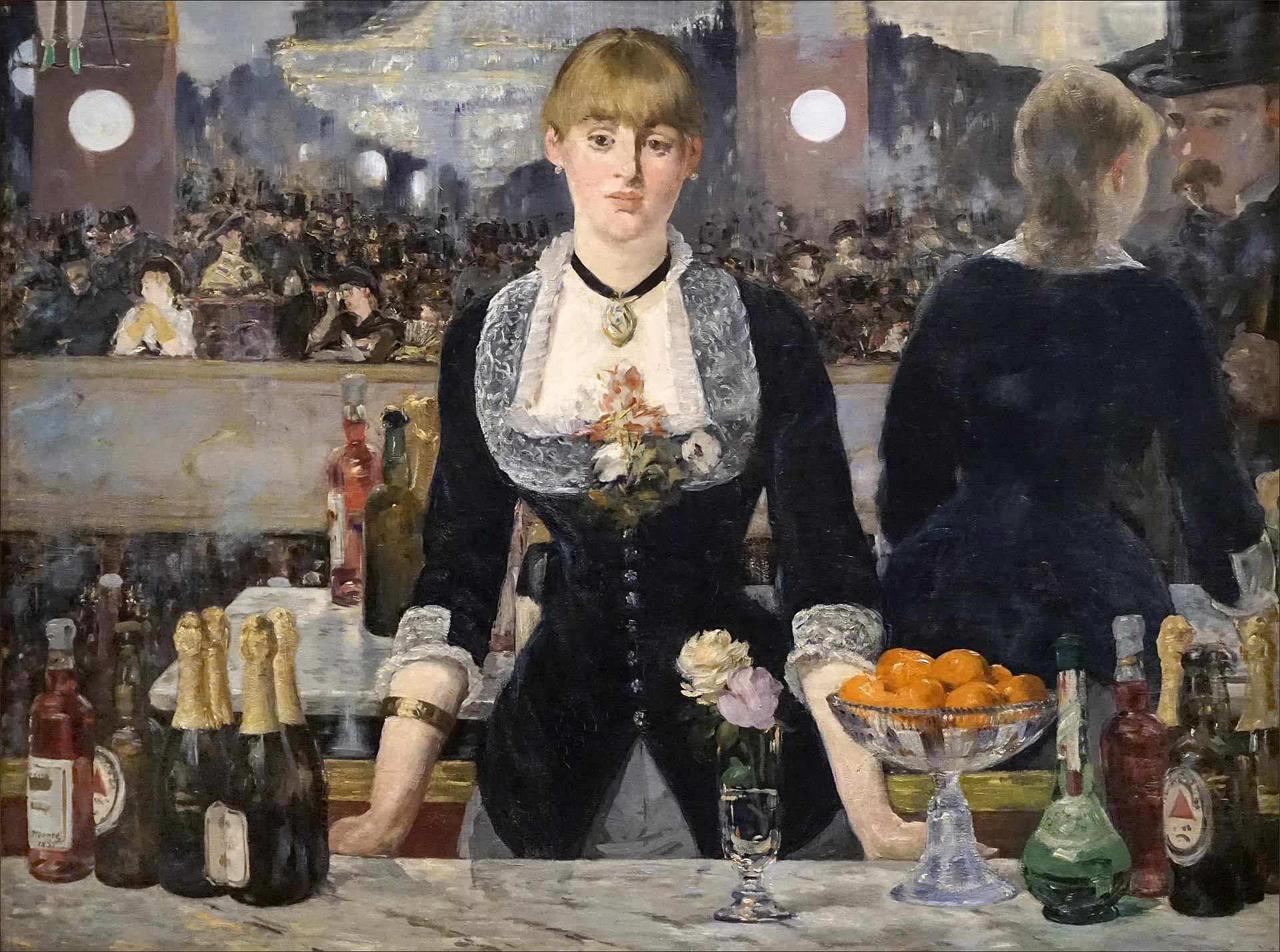
Bass Pale Ale was highly regarded for quality, such that its red triangle was much copied, until it became the first ever British Registered Trademark in 1876. However the brewers did not usually bottle their own beer until the 20th Century; they supplied casks and preprinted labels to export companies and shopkeepers, who then bottled it themselves on their premises, likely sealed with a cork, and with their name overprinted on the Bass label .
Robert Adam was a grocer and wine merchant whose shop was at 6 & 7 Titwood Place, circa 1882-1891. This property includes the rotunda at the end of Alexander Thomson and Robert Turnbull’s tenement of 1876-77. It is now 76 Nithsdale Road, but better known as the New Anand Restaurant.
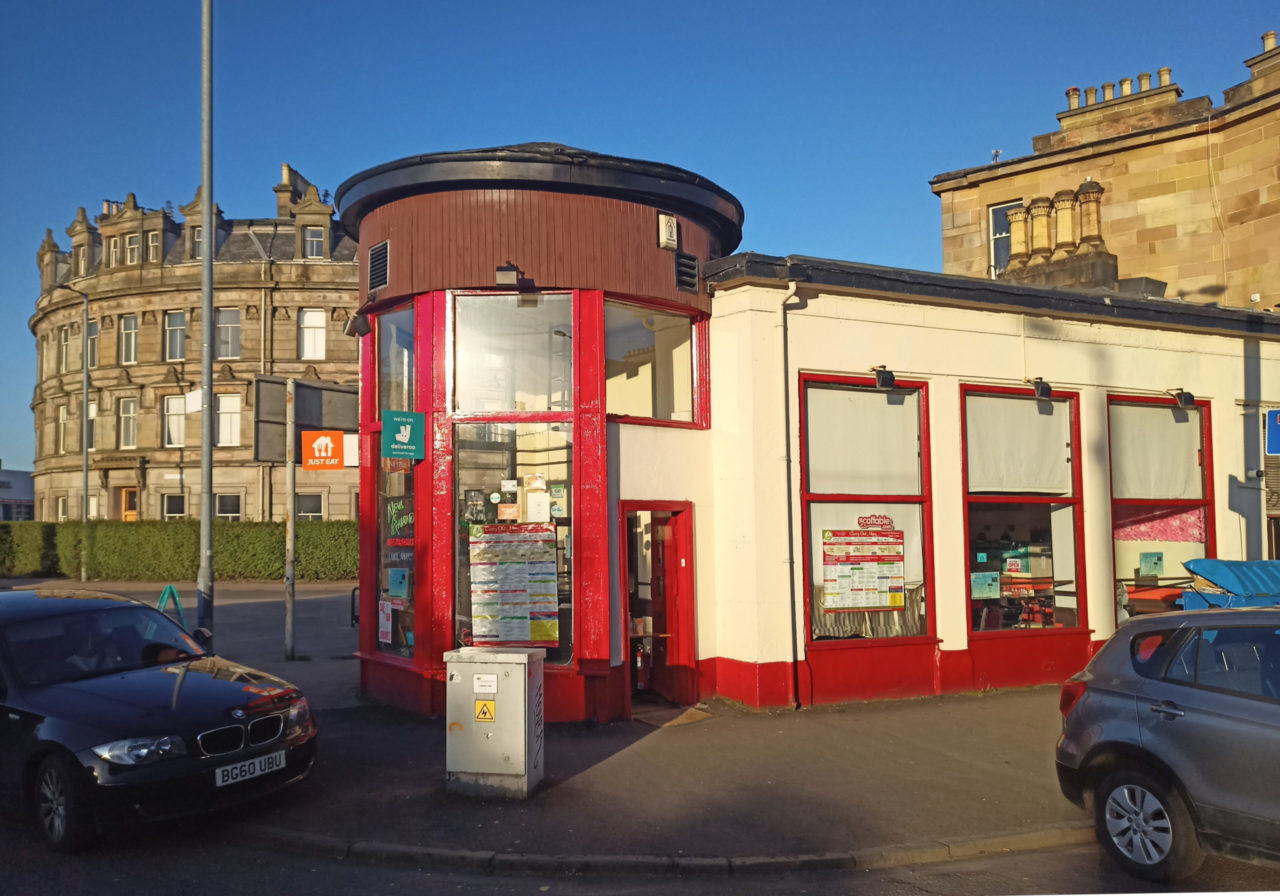
New Anand Restaurant, formerly 6 & 7 Titwood Place
Thus this bottle contained Pale Ale, brewed by Bass in Burton, but bottled in Strathbungo, and seemingly drunk in the attic of a house on Moray Place, all around 1880. The house was built a year or two before the shop, however, so it is unlikely the drinker was also the house builder. What he was up to up there we will never know.
Brick by brick
I then took a walk down the back lane between Queen Square and Marywood Square, which as it happens was built on the site of a Victorian brick factory. Some renovation work was taking place at the back of a house on Queen Square, and there was a pile of old bricks and tiles at the back lane. Picking one up, I noticed it was marked “A Thomson Patent Glasgow”.
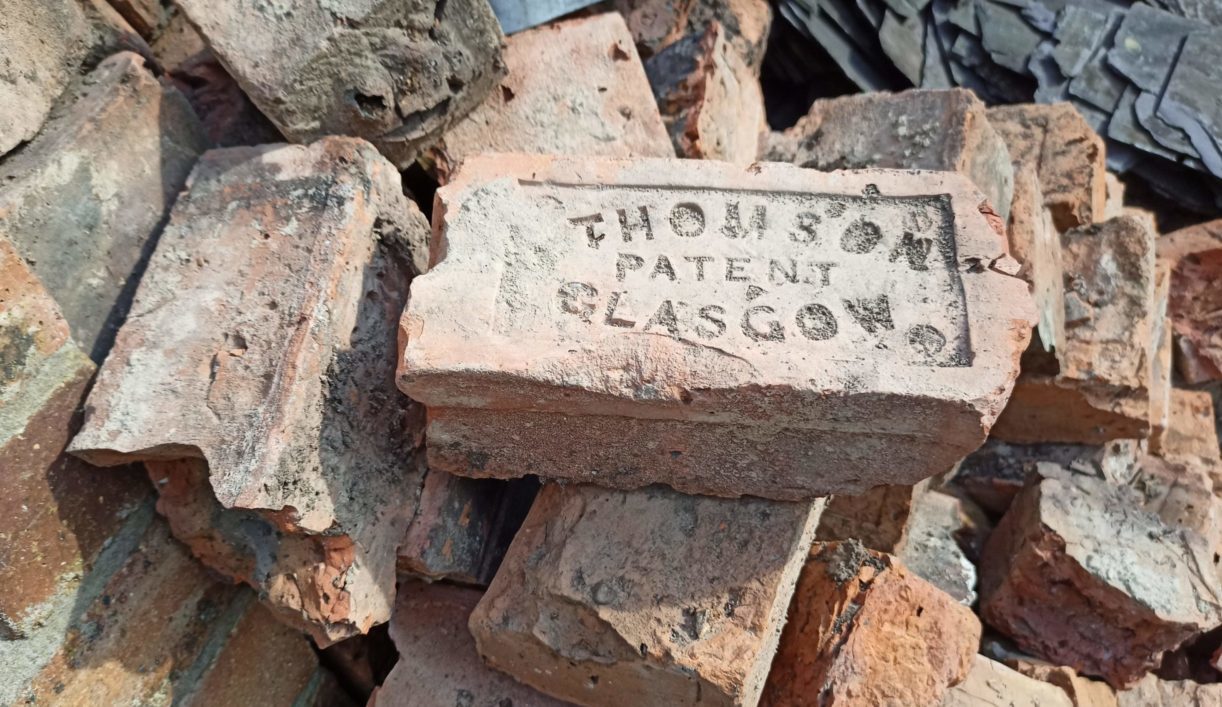
It isn’t the first Thomson brick I have found in Strathbungo, but it is a reminder that Alexander Thomson was the brickmaker who developed the south side of Queen Square in 1880 with his partner, joiner Robert Anderson, and these are the original bricks. They came from his brickworks at Crossbank – now buried under Asda Toryglen .
Meanwhile on the other side of the lane, at the rear of a Marywood Square house, was another pile of bricks left over from renovation work. These were marked “William Aitken Patent Glasgow”.

William Aitken was a brickmaker active around 1875 at Roseknowe Brickwork, Hangingshaw, probably on Aitkenhead Road and immediately south of Alexander Thomson’s brickworks. He lived on Calder Street . The houses on the Marywood Square side are actually older than those on Queen Square, built around 1877-79 by Robert Weir.
So I started looking elsewhere, and here’s another, found a week later in the lane between Marywood Square and Vennard Gardens, “Patent, A McIntyre & Son, Glasgow”.

This one is a little more local; oddly enough in 1885 Andrew MacIntyre’s office was three doors down from Robert Adam’s shop, at 1 Titwood Place (now 65 Nithsdale Street). More significantly, according to the 1885 Valuation Roll, he also appeared to own the entire Titwood Place tenement block, suggesting he was the builder & developer, using Alexander “Greek” Thomson and his partner Robert Turnbull as the architects. His works were at Moss-Side brickworks, Crossmyloof . While I can’t locate this, there was an old clay pit next to Crossmyloof Station, now Durward Court, which may have been the site . Andrew was also the younger brother of John McIntyre, the original developer of Strathbungo and builder of 1-10 Moray Place (See Two Moray Place).
So keep your eyes peeled – what will you find?
(Corrected June 2022: Andrew McIntyre, not Alexander. John McIntyre’s brother)
References
{3557955:7MXNJEKT};{3557955:X935LTTU};{3557955:BZZ6XXYE};{3557955:TFNIJEVQ};{3557955:ABFZBULT};{3557955:PPJ5YCUD};{3557955:2ZLRL48T}
vancouver
asc
0
2985
%7B%22status%22%3A%22success%22%2C%22updateneeded%22%3Afalse%2C%22instance%22%3A%22zotpress-9b26cbe33add87eb2053d883df0f548b%22%2C%22meta%22%3A%7B%22request_last%22%3A0%2C%22request_next%22%3A0%2C%22used_cache%22%3Atrue%7D%2C%22data%22%3A%5B%7B%22key%22%3A%222ZLRL48T%22%2C%22library%22%3A%7B%22id%22%3A3557955%7D%2C%22meta%22%3A%7B%22numChildren%22%3A1%7D%2C%22bib%22%3A%22%3Cdiv%20class%3D%5C%22csl-bib-body%5C%22%20style%3D%5C%22line-height%3A%201.35%3B%20%5C%22%3E%5Cn%20%20%3Cdiv%20class%3D%5C%22csl-entry%5C%22%20style%3D%5C%22clear%3A%20left%3B%20%5C%22%3E%5Cn%20%20%20%20%3Cdiv%20class%3D%5C%22csl-left-margin%5C%22%20style%3D%5C%22float%3A%20left%3B%20padding-right%3A%200.5em%3B%20text-align%3A%20right%3B%20width%3A%201em%3B%5C%22%3E1.%3C%5C%2Fdiv%3E%3Cdiv%20class%3D%5C%22csl-right-inline%5C%22%20style%3D%5C%22margin%3A%200%20.4em%200%201.5em%3B%5C%22%3EView%20map%3A%20Lanarkshire%20X.2%20%28Cathcart%3B%20Eastwood%3B%20Govan%29%20-%20Ordnance%20Survey%2025%20inch%202nd%20and%20later%20editions%2C%20Scotland%2C%201892-1949%20%5BInternet%5D.%20%5Bcited%202021%20Apr%2025%5D.%20Available%20from%3A%20%3Ca%20href%3D%27https%3A%5C%2F%5C%2Fmaps.nls.uk%5C%2Fview%5C%2F82892244%27%3Ehttps%3A%5C%2F%5C%2Fmaps.nls.uk%5C%2Fview%5C%2F82892244%3C%5C%2Fa%3E%3C%5C%2Fdiv%3E%5Cn%20%20%3C%5C%2Fdiv%3E%5Cn%3C%5C%2Fdiv%3E%22%2C%22data%22%3A%7B%22itemType%22%3A%22webpage%22%2C%22title%22%3A%22View%20map%3A%20Lanarkshire%20X.2%20%28Cathcart%3B%20Eastwood%3B%20Govan%29%20-%20Ordnance%20Survey%2025%20inch%202nd%20and%20later%20editions%2C%20Scotland%2C%201892-1949%22%2C%22creators%22%3A%5B%5D%2C%22abstractNote%22%3A%22%22%2C%22date%22%3A%22%22%2C%22url%22%3A%22https%3A%5C%2F%5C%2Fmaps.nls.uk%5C%2Fview%5C%2F82892244%22%2C%22language%22%3A%22%22%2C%22collections%22%3A%5B%22CAR6MXPM%22%5D%2C%22dateModified%22%3A%222021-04-25T22%3A12%3A33Z%22%7D%7D%2C%7B%22key%22%3A%22PPJ5YCUD%22%2C%22library%22%3A%7B%22id%22%3A3557955%7D%2C%22meta%22%3A%7B%22numChildren%22%3A1%7D%2C%22bib%22%3A%22%3Cdiv%20class%3D%5C%22csl-bib-body%5C%22%20style%3D%5C%22line-height%3A%201.35%3B%20%5C%22%3E%5Cn%20%20%3Cdiv%20class%3D%5C%22csl-entry%5C%22%20style%3D%5C%22clear%3A%20left%3B%20%5C%22%3E%5Cn%20%20%20%20%3Cdiv%20class%3D%5C%22csl-left-margin%5C%22%20style%3D%5C%22float%3A%20left%3B%20padding-right%3A%200.5em%3B%20text-align%3A%20right%3B%20width%3A%201em%3B%5C%22%3E1.%3C%5C%2Fdiv%3E%3Cdiv%20class%3D%5C%22csl-right-inline%5C%22%20style%3D%5C%22margin%3A%200%20.4em%200%201.5em%3B%5C%22%3EMoss%20Side%20Brickworks%2C%20Crossmyloof%2C%20Glasgow.%20%7C%20Scotland%26%23x2019%3Bs%20Brick%20and%20Tile%20Manufacturing%20Industry%20%5BInternet%5D.%20%5Bcited%202021%20Apr%2025%5D.%20Available%20from%3A%20%3Ca%20href%3D%27https%3A%5C%2F%5C%2Fwww.scottishbrickhistory.co.uk%5C%2Fmoss-side-brickworks-crossmyloof-glasgow%5C%2F%27%3Ehttps%3A%5C%2F%5C%2Fwww.scottishbrickhistory.co.uk%5C%2Fmoss-side-brickworks-crossmyloof-glasgow%5C%2F%3C%5C%2Fa%3E%3C%5C%2Fdiv%3E%5Cn%20%20%3C%5C%2Fdiv%3E%5Cn%3C%5C%2Fdiv%3E%22%2C%22data%22%3A%7B%22itemType%22%3A%22blogPost%22%2C%22title%22%3A%22Moss%20Side%20Brickworks%2C%20Crossmyloof%2C%20Glasgow.%20%7C%20Scotland%27s%20Brick%20and%20Tile%20Manufacturing%20Industry%22%2C%22creators%22%3A%5B%5D%2C%22abstractNote%22%3A%22%22%2C%22blogTitle%22%3A%22%22%2C%22date%22%3A%22%22%2C%22url%22%3A%22https%3A%5C%2F%5C%2Fwww.scottishbrickhistory.co.uk%5C%2Fmoss-side-brickworks-crossmyloof-glasgow%5C%2F%22%2C%22language%22%3A%22en-GB%22%2C%22collections%22%3A%5B%22CAR6MXPM%22%5D%2C%22dateModified%22%3A%222021-04-25T21%3A54%3A20Z%22%7D%7D%2C%7B%22key%22%3A%227MXNJEKT%22%2C%22library%22%3A%7B%22id%22%3A3557955%7D%2C%22meta%22%3A%7B%22parsedDate%22%3A%222021-03-25%22%2C%22numChildren%22%3A1%7D%2C%22bib%22%3A%22%3Cdiv%20class%3D%5C%22csl-bib-body%5C%22%20style%3D%5C%22line-height%3A%201.35%3B%20%5C%22%3E%5Cn%20%20%3Cdiv%20class%3D%5C%22csl-entry%5C%22%20style%3D%5C%22clear%3A%20left%3B%20%5C%22%3E%5Cn%20%20%20%20%3Cdiv%20class%3D%5C%22csl-left-margin%5C%22%20style%3D%5C%22float%3A%20left%3B%20padding-right%3A%200.5em%3B%20text-align%3A%20right%3B%20width%3A%201em%3B%5C%22%3E1.%3C%5C%2Fdiv%3E%3Cdiv%20class%3D%5C%22csl-right-inline%5C%22%20style%3D%5C%22margin%3A%200%20.4em%200%201.5em%3B%5C%22%3EEdmondson%20railway%20ticket.%20In%3A%20Wikipedia%20%5BInternet%5D.%202021%20%5Bcited%202021%20Apr%2021%5D.%20Available%20from%3A%20%3Ca%20href%3D%27https%3A%5C%2F%5C%2Fen.wikipedia.org%5C%2Fw%5C%2Findex.php%3Ftitle%3DEdmondson_railway_ticket%26oldid%3D1014217586%27%3Ehttps%3A%5C%2F%5C%2Fen.wikipedia.org%5C%2Fw%5C%2Findex.php%3Ftitle%3DEdmondson_railway_ticket%26oldid%3D1014217586%3C%5C%2Fa%3E%3C%5C%2Fdiv%3E%5Cn%20%20%3C%5C%2Fdiv%3E%5Cn%3C%5C%2Fdiv%3E%22%2C%22data%22%3A%7B%22itemType%22%3A%22encyclopediaArticle%22%2C%22title%22%3A%22Edmondson%20railway%20ticket%22%2C%22creators%22%3A%5B%5D%2C%22abstractNote%22%3A%22The%20Edmondson%20railway%20ticket%20was%20a%20system%20for%20recording%20the%20payment%20of%20railway%20fares%20and%20accounting%20for%20the%20revenue%20raised%2C%20introduced%20in%20the%201840s.%20%20It%20is%20named%20after%20its%20inventor%2C%20Thomas%20Edmondson%2C%20a%20trained%20cabinet%20maker%2C%20who%20became%20a%20station%20master%20on%20the%20Newcastle%20and%20Carlisle%20Railway%20in%20England.He%20introduced%20his%20system%20on%20the%20Manchester%20and%20Leeds%20Railway.%20Previously%2C%20railway%20companies%20had%20used%20handwritten%20tickets%2C%20as%20was%20the%20practice%20for%20stagecoaches%2C%20but%20it%20was%20laborious%20for%20a%20ticket%20clerk%20to%20write%20out%20a%20ticket%20for%20each%20passenger%20and%20long%20queues%20were%20common%20at%20busy%20stations.%20%5CnA%20faster%20means%20of%20issuing%20pre-printed%20tickets%20was%20needed.%20There%20was%20also%20a%20need%20to%20provide%20accountability%20by%20serial-numbering%20each%20ticket%20to%20prevent%20unscrupulous%20clerks%20from%20pocketing%20the%20fares%2C%20who%20now%20had%20to%20reconcile%20the%20takings%20against%20the%20serial%20numbers%20of%20the%20unsold%20tickets%20at%20the%20end%20of%20each%20day.%5CnThe%20Edmondson%20system%20came%20into%20general%20use%20with%20the%20creation%20of%20the%20Railway%20Clearing%20House%20in%201842%2C%20becoming%20%27the%20essential%20standard%20feature.%27%22%2C%22encyclopediaTitle%22%3A%22Wikipedia%22%2C%22date%22%3A%222021-03-25T20%3A50%3A18Z%22%2C%22ISBN%22%3A%22%22%2C%22url%22%3A%22https%3A%5C%2F%5C%2Fen.wikipedia.org%5C%2Fw%5C%2Findex.php%3Ftitle%3DEdmondson_railway_ticket%26oldid%3D1014217586%22%2C%22language%22%3A%22en%22%2C%22collections%22%3A%5B%22CAR6MXPM%22%5D%2C%22dateModified%22%3A%222021-04-21T21%3A01%3A23Z%22%7D%7D%2C%7B%22key%22%3A%22X935LTTU%22%2C%22library%22%3A%7B%22id%22%3A3557955%7D%2C%22meta%22%3A%7B%22creatorSummary%22%3A%22Hands%22%2C%22parsedDate%22%3A%222018%22%2C%22numChildren%22%3A1%7D%2C%22bib%22%3A%22%3Cdiv%20class%3D%5C%22csl-bib-body%5C%22%20style%3D%5C%22line-height%3A%201.35%3B%20%5C%22%3E%5Cn%20%20%3Cdiv%20class%3D%5C%22csl-entry%5C%22%20style%3D%5C%22clear%3A%20left%3B%20%5C%22%3E%5Cn%20%20%20%20%3Cdiv%20class%3D%5C%22csl-left-margin%5C%22%20style%3D%5C%22float%3A%20left%3B%20padding-right%3A%200.5em%3B%20text-align%3A%20right%3B%20width%3A%201em%3B%5C%22%3E1.%3C%5C%2Fdiv%3E%3Cdiv%20class%3D%5C%22csl-right-inline%5C%22%20style%3D%5C%22margin%3A%200%20.4em%200%201.5em%3B%5C%22%3EHands%20T.%20Selling%20%26%23x2018%3Bthe%20Drink%20of%20the%20Empire%26%23x2019%3B%3A%20Bass%20%26amp%3B%20Co.%20Ltd.%20In%3A%20Hands%20T%2C%20editor.%20Drinking%20in%20Victorian%20and%20Edwardian%20Britain%3A%20Beyond%20the%20Spectre%20of%20the%20Drunkard%20%5BInternet%5D.%20Cham%3A%20Springer%20International%20Publishing%3B%202018%20%5Bcited%202021%20Apr%2021%5D.%20p.%2059%26%23x2013%3B68.%20Available%20from%3A%20%3Ca%20href%3D%27https%3A%5C%2F%5C%2Fdoi.org%5C%2F10.1007%5C%2F978-3-319-92964-4_6%27%3Ehttps%3A%5C%2F%5C%2Fdoi.org%5C%2F10.1007%5C%2F978-3-319-92964-4_6%3C%5C%2Fa%3E%3C%5C%2Fdiv%3E%5Cn%20%20%3C%5C%2Fdiv%3E%5Cn%3C%5C%2Fdiv%3E%22%2C%22data%22%3A%7B%22itemType%22%3A%22bookSection%22%2C%22title%22%3A%22Selling%20%5Cu2018the%20Drink%20of%20the%20Empire%5Cu2019%3A%20Bass%20%26%20Co.%20Ltd%22%2C%22creators%22%3A%5B%7B%22creatorType%22%3A%22author%22%2C%22firstName%22%3A%22Thora%22%2C%22lastName%22%3A%22Hands%22%7D%2C%7B%22creatorType%22%3A%22editor%22%2C%22firstName%22%3A%22Thora%22%2C%22lastName%22%3A%22Hands%22%7D%5D%2C%22abstractNote%22%3A%22This%20chapter%20considers%20the%20tactics%20of%20the%20brewing%20industry%20by%20focusing%20on%20one%20of%20the%20largest%20and%20most%20successful%20brewers%20in%20Britain%2C%20Bass%20%26%20Co.%20Ltd.%20In%20order%20to%20compete%20in%20a%20growing%20domestic%20and%20foreign%20market%20for%20beer%2C%20Bass%20began%20to%20use%20advertising%20as%20a%20means%20of%20reaching%20larger%20groups%20of%20consumers.%20By%20appealing%20to%20notions%20of%20Britishness%20and%20Empire%2C%20Bass%20secured%20a%20market%20for%20their%20products%20and%20established%20a%20strong%20brand%20image.%20The%20company%20also%20used%20ideas%20about%20the%20supposed%20health%20giving%20properties%20of%20beer%20in%20order%20to%20boost%20dwindling%20sales%20towards%20the%20end%20of%20the%20century.%22%2C%22bookTitle%22%3A%22Drinking%20in%20Victorian%20and%20Edwardian%20Britain%3A%20Beyond%20the%20Spectre%20of%20the%20Drunkard%22%2C%22date%22%3A%222018%22%2C%22language%22%3A%22en%22%2C%22ISBN%22%3A%22978-3-319-92964-4%22%2C%22url%22%3A%22https%3A%5C%2F%5C%2Fdoi.org%5C%2F10.1007%5C%2F978-3-319-92964-4_6%22%2C%22collections%22%3A%5B%22CAR6MXPM%22%5D%2C%22dateModified%22%3A%222021-04-21T20%3A48%3A47Z%22%7D%7D%2C%7B%22key%22%3A%22ABFZBULT%22%2C%22library%22%3A%7B%22id%22%3A3557955%7D%2C%22meta%22%3A%7B%22numChildren%22%3A1%7D%2C%22bib%22%3A%22%3Cdiv%20class%3D%5C%22csl-bib-body%5C%22%20style%3D%5C%22line-height%3A%201.35%3B%20%5C%22%3E%5Cn%20%20%3Cdiv%20class%3D%5C%22csl-entry%5C%22%20style%3D%5C%22clear%3A%20left%3B%20%5C%22%3E%5Cn%20%20%20%20%3Cdiv%20class%3D%5C%22csl-left-margin%5C%22%20style%3D%5C%22float%3A%20left%3B%20padding-right%3A%200.5em%3B%20text-align%3A%20right%3B%20width%3A%201em%3B%5C%22%3E1.%3C%5C%2Fdiv%3E%3Cdiv%20class%3D%5C%22csl-right-inline%5C%22%20style%3D%5C%22margin%3A%200%20.4em%200%201.5em%3B%5C%22%3ERoseknowe%20Brickwork%2C%20Hangingshaw%2C%20Glasgow%20%7C%20Scotland%26%23x2019%3Bs%20Brick%20and%20Tile%20Manufacturing%20Industry%20%5BInternet%5D.%20%5Bcited%202021%20Apr%2021%5D.%20Available%20from%3A%20%3Ca%20href%3D%27https%3A%5C%2F%5C%2Fwww.scottishbrickhistory.co.uk%5C%2Froseknowe-brickwork-hangingshaw-glasgow%5C%2F%27%3Ehttps%3A%5C%2F%5C%2Fwww.scottishbrickhistory.co.uk%5C%2Froseknowe-brickwork-hangingshaw-glasgow%5C%2F%3C%5C%2Fa%3E%3C%5C%2Fdiv%3E%5Cn%20%20%3C%5C%2Fdiv%3E%5Cn%3C%5C%2Fdiv%3E%22%2C%22data%22%3A%7B%22itemType%22%3A%22blogPost%22%2C%22title%22%3A%22Roseknowe%20Brickwork%2C%20Hangingshaw%2C%20Glasgow%20%7C%20Scotland%27s%20Brick%20and%20Tile%20Manufacturing%20Industry%22%2C%22creators%22%3A%5B%5D%2C%22abstractNote%22%3A%22%22%2C%22blogTitle%22%3A%22%22%2C%22date%22%3A%22%22%2C%22url%22%3A%22https%3A%5C%2F%5C%2Fwww.scottishbrickhistory.co.uk%5C%2Froseknowe-brickwork-hangingshaw-glasgow%5C%2F%22%2C%22language%22%3A%22en-GB%22%2C%22collections%22%3A%5B%22CAR6MXPM%22%5D%2C%22dateModified%22%3A%222021-04-21T20%3A37%3A59Z%22%7D%7D%2C%7B%22key%22%3A%22TFNIJEVQ%22%2C%22library%22%3A%7B%22id%22%3A3557955%7D%2C%22meta%22%3A%7B%22numChildren%22%3A1%7D%2C%22bib%22%3A%22%3Cdiv%20class%3D%5C%22csl-bib-body%5C%22%20style%3D%5C%22line-height%3A%201.35%3B%20%5C%22%3E%5Cn%20%20%3Cdiv%20class%3D%5C%22csl-entry%5C%22%20style%3D%5C%22clear%3A%20left%3B%20%5C%22%3E%5Cn%20%20%20%20%3Cdiv%20class%3D%5C%22csl-left-margin%5C%22%20style%3D%5C%22float%3A%20left%3B%20padding-right%3A%200.5em%3B%20text-align%3A%20right%3B%20width%3A%201em%3B%5C%22%3E1.%3C%5C%2Fdiv%3E%3Cdiv%20class%3D%5C%22csl-right-inline%5C%22%20style%3D%5C%22margin%3A%200%20.4em%200%201.5em%3B%5C%22%3ECrossbank%20Brickworks%2C%20Nr%20Hangingshaw%2C%20Glasgow%20%7C%20Scotland%26%23x2019%3Bs%20Brick%20and%20Tile%20Manufacturing%20Industry%20%5BInternet%5D.%20%5Bcited%202021%20Apr%2020%5D.%20Available%20from%3A%20%3Ca%20href%3D%27https%3A%5C%2F%5C%2Fwww.scottishbrickhistory.co.uk%5C%2Fcrossbank-brickworks-nr-hangingshaw-glasgow%5C%2F%27%3Ehttps%3A%5C%2F%5C%2Fwww.scottishbrickhistory.co.uk%5C%2Fcrossbank-brickworks-nr-hangingshaw-glasgow%5C%2F%3C%5C%2Fa%3E%3C%5C%2Fdiv%3E%5Cn%20%20%3C%5C%2Fdiv%3E%5Cn%3C%5C%2Fdiv%3E%22%2C%22data%22%3A%7B%22itemType%22%3A%22blogPost%22%2C%22title%22%3A%22Crossbank%20Brickworks%2C%20Nr%20Hangingshaw%2C%20Glasgow%20%7C%20Scotland%27s%20Brick%20and%20Tile%20Manufacturing%20Industry%22%2C%22creators%22%3A%5B%5D%2C%22abstractNote%22%3A%22%22%2C%22blogTitle%22%3A%22%22%2C%22date%22%3A%22%22%2C%22url%22%3A%22https%3A%5C%2F%5C%2Fwww.scottishbrickhistory.co.uk%5C%2Fcrossbank-brickworks-nr-hangingshaw-glasgow%5C%2F%22%2C%22language%22%3A%22en-GB%22%2C%22collections%22%3A%5B%22CAR6MXPM%22%5D%2C%22dateModified%22%3A%222021-04-20T22%3A56%3A19Z%22%7D%7D%2C%7B%22key%22%3A%22BZZ6XXYE%22%2C%22library%22%3A%7B%22id%22%3A3557955%7D%2C%22meta%22%3A%7B%22parsedDate%22%3A%222013-11-05%22%2C%22numChildren%22%3A1%7D%2C%22bib%22%3A%22%3Cdiv%20class%3D%5C%22csl-bib-body%5C%22%20style%3D%5C%22line-height%3A%201.35%3B%20%5C%22%3E%5Cn%20%20%3Cdiv%20class%3D%5C%22csl-entry%5C%22%20style%3D%5C%22clear%3A%20left%3B%20%5C%22%3E%5Cn%20%20%20%20%3Cdiv%20class%3D%5C%22csl-left-margin%5C%22%20style%3D%5C%22float%3A%20left%3B%20padding-right%3A%200.5em%3B%20text-align%3A%20right%3B%20width%3A%201em%3B%5C%22%3E1.%3C%5C%2Fdiv%3E%3Cdiv%20class%3D%5C%22csl-right-inline%5C%22%20style%3D%5C%22margin%3A%200%20.4em%200%201.5em%3B%5C%22%3EThe%20History%20Of%20Beer%20Labels%20%5BInternet%5D.%20Retrorambling.%202013%20%5Bcited%202021%20Apr%2019%5D.%20Available%20from%3A%20%3Ca%20href%3D%27https%3A%5C%2F%5C%2Fretrorambling.wordpress.com%5C%2Farticles%5C%2Fmisc-articles%5C%2Fthe-history-of-beer-labels%5C%2F%27%3Ehttps%3A%5C%2F%5C%2Fretrorambling.wordpress.com%5C%2Farticles%5C%2Fmisc-articles%5C%2Fthe-history-of-beer-labels%5C%2F%3C%5C%2Fa%3E%3C%5C%2Fdiv%3E%5Cn%20%20%3C%5C%2Fdiv%3E%5Cn%3C%5C%2Fdiv%3E%22%2C%22data%22%3A%7B%22itemType%22%3A%22blogPost%22%2C%22title%22%3A%22The%20History%20Of%20Beer%20Labels%22%2C%22creators%22%3A%5B%5D%2C%22abstractNote%22%3A%22From%20%5Cu201cThe%20International%20Book%20of%20Beer%20Labels%2C%20Mats%20%26%20Coasters%5Cu201d%20published%20by%20Chartwell%20books%20in%201979%20Bottled%20products%20bore%20paper%20labels%20in%20the%20seventeenth%20century.%20Early%20drug%20phials%20had%20a%20label%20w%5Cu2026%22%2C%22blogTitle%22%3A%22Retrorambling%22%2C%22date%22%3A%222013-11-05T18%3A29%3A37%2B00%3A00%22%2C%22url%22%3A%22https%3A%5C%2F%5C%2Fretrorambling.wordpress.com%5C%2Farticles%5C%2Fmisc-articles%5C%2Fthe-history-of-beer-labels%5C%2F%22%2C%22language%22%3A%22en%22%2C%22collections%22%3A%5B%22CAR6MXPM%22%5D%2C%22dateModified%22%3A%222021-04-19T22%3A19%3A21Z%22%7D%7D%5D%7D
1.
View map: Lanarkshire X.2 (Cathcart; Eastwood; Govan) - Ordnance Survey 25 inch 2nd and later editions, Scotland, 1892-1949 [Internet]. [cited 2021 Apr 25]. Available from:
https://maps.nls.uk/view/82892244
1.
Hands T. Selling ‘the Drink of the Empire’: Bass & Co. Ltd. In: Hands T, editor. Drinking in Victorian and Edwardian Britain: Beyond the Spectre of the Drunkard [Internet]. Cham: Springer International Publishing; 2018 [cited 2021 Apr 21]. p. 59–68. Available from:
https://doi.org/10.1007/978-3-319-92964-4_6
Like this:
Like Loading...








May 5, 2021 at 11:33 pm
I’m just in my 50’s and I remember when Maxwell Park, and Pollokshields West, were both still manned and it was the old style tickets that were used. Unlike Central which dispensed tickets for the ticket clerk from a machine, the tickets at MP and PW were just hanging rolls on a nail.